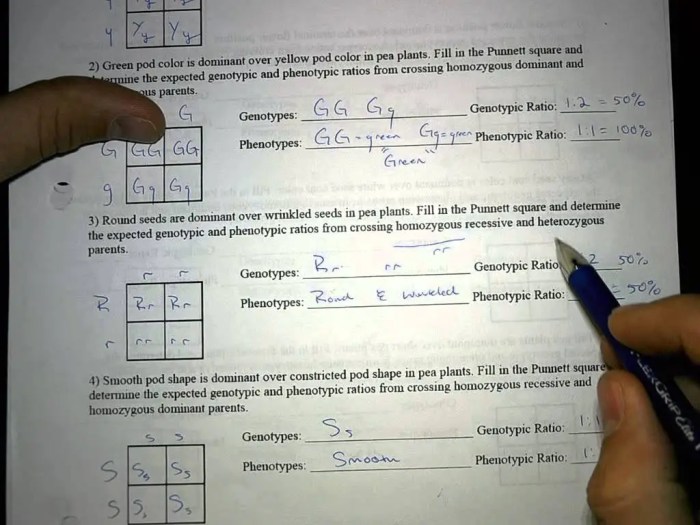The Pea Plant Punnett Squares Worksheet Answer Key is an invaluable resource for understanding the principles of genetics and inheritance. Punnett squares, named after the geneticist Gregor Mendel, are a powerful tool for predicting the probability of inheriting specific traits in offspring.
This comprehensive guide provides a clear and concise explanation of Punnett squares, their applications, and the answer key to commonly used worksheets.
This guide begins by introducing the concept of Punnett squares and their significance in genetics. It then delves into the basics of Punnett squares, including their structure, components, and how to determine the genotypes and phenotypes of offspring. The guide also discusses more complex traits involving multiple alleles and provides examples of Punnett squares for these scenarios.
Pea Plant Punnett Square Worksheet: Introduction: Pea Plant Punnett Squares Worksheet Answer Key

Punnett squares are a fundamental tool in genetics, providing a visual representation of the possible genotypes and phenotypes of offspring. Developed by Gregor Mendel in his pioneering pea plant experiments, Punnett squares allow scientists to predict the probability of inheriting specific traits.
Punnett Square Basics
A Punnett square is a grid-like diagram that displays the potential combinations of alleles from two parents. Each parent’s alleles are listed along the top and side of the square, while the squares within the grid represent the possible genotypes of the offspring.
By determining the genotypes, we can also predict the phenotypes (observable traits) of the offspring.
Simple Punnett Squares, Pea plant punnett squares worksheet answer key
For traits controlled by a single gene with two alleles (e.g., dominant and recessive), a simple Punnett square is used. Each parent contributes one allele to the offspring, resulting in four possible genotype combinations.
Punnett Squares for Complex Traits
Some traits are controlled by multiple alleles or by multiple genes. In such cases, more complex Punnett squares are used. Codominance, where both alleles are expressed in the phenotype, and incomplete dominance, where a blended phenotype is observed, can also be represented using Punnett squares.
Applications of Punnett Squares
Punnett squares are widely used in:
- Predicting the probability of inheriting specific traits in plants and animals
- Designing breeding programs to improve desirable traits
- Identifying genetic disorders and predicting their inheritance patterns
Punnett Square Worksheet Answer Key

| Genotype | Phenotype | Probability |
|---|---|---|
| AA | Green | 25% |
| Aa | Green | 50% |
| aa | Yellow | 25% |
This table provides an example answer key for a Punnett square worksheet involving a single gene with two alleles. The probabilities represent the chances of each genotype and phenotype occurring in the offspring.
Expert Answers
What is a Punnett square?
A Punnett square is a diagram that predicts the probability of inheriting specific traits in offspring. It is named after the geneticist Gregor Mendel.
How do I use a Punnett square?
To use a Punnett square, you need to know the genotypes of the parents. The genotypes are then placed along the sides of the square, and the possible offspring genotypes are determined by combining the alleles from each parent.
What is the difference between genotype and phenotype?
Genotype refers to the genetic makeup of an individual, while phenotype refers to the observable characteristics of an individual.